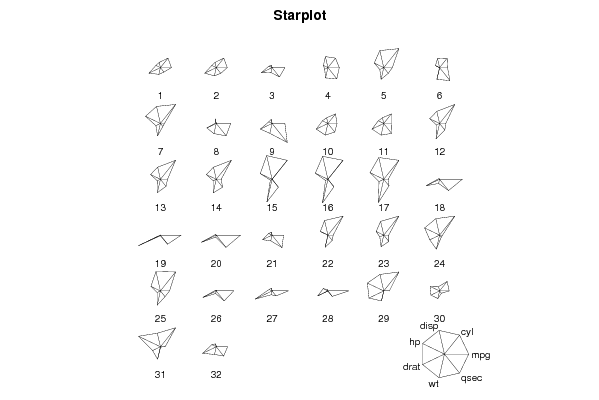Free Statistics
of Irreproducible Research!
Description of Statistical Computation | |||||||||||||||||||||
|---|---|---|---|---|---|---|---|---|---|---|---|---|---|---|---|---|---|---|---|---|---|
| Author's title | |||||||||||||||||||||
| Author | *The author of this computation has been verified* | ||||||||||||||||||||
| R Software Module | rwasp_starplot.wasp | ||||||||||||||||||||
| Title produced by software | Star Plot | ||||||||||||||||||||
| Date of computation | Tue, 04 Nov 2008 08:08:14 -0700 | ||||||||||||||||||||
| Cite this page as follows | Statistical Computations at FreeStatistics.org, Office for Research Development and Education, URL https://freestatistics.org/blog/index.php?v=date/2008/Nov/04/t12258113698d2deslf1jkvf9h.htm/, Retrieved Sat, 18 May 2024 23:42:04 +0000 | ||||||||||||||||||||
| Statistical Computations at FreeStatistics.org, Office for Research Development and Education, URL https://freestatistics.org/blog/index.php?pk=21581, Retrieved Sat, 18 May 2024 23:42:04 +0000 | |||||||||||||||||||||
| QR Codes: | |||||||||||||||||||||
|
| |||||||||||||||||||||
| Original text written by user: | |||||||||||||||||||||
| IsPrivate? | No (this computation is public) | ||||||||||||||||||||
| User-defined keywords | |||||||||||||||||||||
| Estimated Impact | 144 | ||||||||||||||||||||
Tree of Dependent Computations | |||||||||||||||||||||
| Family? (F = Feedback message, R = changed R code, M = changed R Module, P = changed Parameters, D = changed Data) | |||||||||||||||||||||
| F [Star Plot] [Starplot] [2008-11-04 15:08:14] [98255691c21504803b38711776845ae0] [Current] | |||||||||||||||||||||
| Feedback Forum | |||||||||||||||||||||
Post a new message | |||||||||||||||||||||
Dataset | |||||||||||||||||||||
| Dataseries X: | |||||||||||||||||||||
21 6 160 110 3.9 2.62 16.46 21 6 160 110 3.9 2.875 17.02 22.8 4 108 93 3.85 2.32 18.61 21.4 6 258 110 3.08 3.215 19.44 18.7 8 360 175 3.15 3.44 17.02 18.1 6 225 105 2.76 3.46 20.22 14.3 8 360 245 3.21 3.57 15.84 24.4 4 146.7 62 3.69 3.19 20 22.8 4 140.8 95 3.92 3.15 22.9 19.2 6 167.6 123 3.92 3.44 18.3 17.8 6 167.6 123 3.92 3.44 18.9 16.4 8 275.8 180 3.07 4.07 17.4 17.3 8 275.8 180 3.07 3.73 17.6 15.2 8 275.8 180 3.07 3.78 18 10.4 8 472 205 2.93 5.25 17.98 10.4 8 460 215 3 5.424 17.82 14.7 8 440 230 3.23 5.345 17.42 32.4 4 78.7 66 4.08 2.2 19.47 30.4 4 75.7 52 4.93 1.615 18.52 33.9 4 71.1 65 4.22 1.835 19.9 21.5 4 120.1 97 3.7 2.465 20.01 15.5 8 318 150 2.76 3.52 16.87 15.2 8 304 150 3.15 3.435 17.3 13.3 8 350 245 3.73 3.84 15.41 19.2 8 400 175 3.08 3.845 17.05 27.3 4 79 66 4.08 1.935 18.9 26 4 120.3 91 4.43 2.14 16.7 30.4 4 95.1 113 3.77 1.513 16.9 15.8 8 351 264 4.22 3.17 14.5 19.7 6 145 175 3.62 2.77 15.5 15 8 301 335 3.54 3.57 14.6 21.4 4 121 109 4.11 2.78 18.6 | |||||||||||||||||||||
Tables (Output of Computation) | |||||||||||||||||||||
| |||||||||||||||||||||
Figures (Output of Computation) | |||||||||||||||||||||
Input Parameters & R Code | |||||||||||||||||||||
| Parameters (Session): | |||||||||||||||||||||
| par1 = TRUE ; | |||||||||||||||||||||
| Parameters (R input): | |||||||||||||||||||||
| par1 = TRUE ; | |||||||||||||||||||||
| R code (references can be found in the software module): | |||||||||||||||||||||
if (par1 == 'TRUE') par1 <- TRUE | |||||||||||||||||||||





